Enzymes & Digestion - Protein and Lipids: Breakdown (GCSE Biology)
Protein and Lipids: Breakdown
Food Groups
- Foods are divided into three groups. Simply, all food can be divided into carbohydrates, proteins and lipids.
- These groups are made of different elements.
- Lipids are made of carbon, oxygen and hydrogen.
- Proteins are made of carbon, oxygen, hydrogen and nitrogen.
- Large molecules (polymers) are made from smaller molecules (monomers).
- Proteins are made from amino acids
- Fats and oils are made from fatty acids and glycerol.
We will learn about the digestion of each of these groups below. This flow chart shows the three enzyme types involved in digestion of each food group:
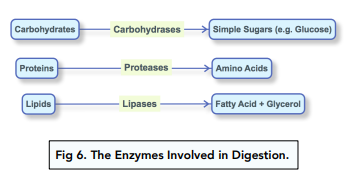
Digestion of Proteins
Function of Proteases
- Proteins are hydrolysed by protease enzymes. Proteins are converted into amino acids by protease enzymes.
- Proteins are broken down in two stages. Like carbohydrates, proteins are broken down in two stages. First, the protein is broken down into a dipeptide (containing 2 amino acids), and second the dipeptide is split into individual amino acids.
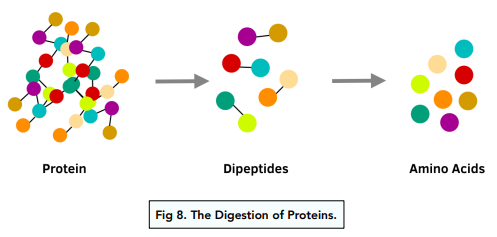
Location of Proteases
Protein digestion happens in two key places:
- Stomach – a protease enzyme called pepsin converts proteins into amino acids. As pepsin is made and released in the stomach, it has an optimum pH is 2. Hydrochloric acid helps set this low pH as well as killing any harmful microorganisms in the food.
- Small intestine (duodenum) – the pancreatic juice also contains protease enzymes, including trypsin. Trypsin convert proteins into amino acids, just like pepsin.
Function of Amino Acids
- Amino acids are used by the body to make proteins. They are made in protein synthesis.
- Different sequences of amino acids give rise to differently shaped protein molecules.
- The shape of proteins determines their function and gives them specificity. For example:
- Active sites in enzymes for specific substrates
- Antibody binding sites for specific antigens
Digestion of Lipids
Function of Lipases
- Lipids are hydrolysed by lipases. Lipases break down lipids into fatty acids and glycerol. They are made in the pancreas and secreted into the small intestine.
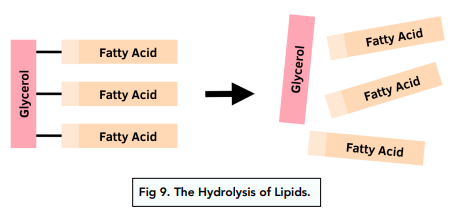
Location of Lipases
Lipid digestion happens in one key place:
- Small intestine (duodenum) – the pancreatic juice also contains lipase enzymes. Lipase converts the lipids into fatty acids and glycerol.
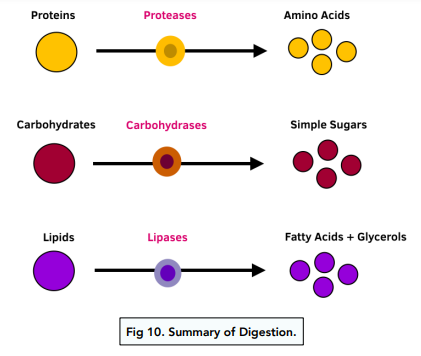
Bile
- Before lipids can be hydrolysed, they need to be emulsified. Emulsification is the process by which large lipids are broken into tiny lipid droplets. Emulsification increases the surface area of lipids, which helps to speed up the activity of lipase (lipid-digesting) enzymes.
- Bile emulsifies lipids in the duodenum. Bile is a substance which is produced by the liver and stored in the gallbladder. During digestion, bile is released from the gallbladder and transported to the duodenum by bile ducts. The bile then emulsifies the lipids.
- Bile aids digestion with its alkaline nature. Bile is alkaline and so neutralises the contents that have left the stomach and entered the small intestine. This is helpful as it allows the trypsin, lipase and carbohydrase to act at their optimum pH.
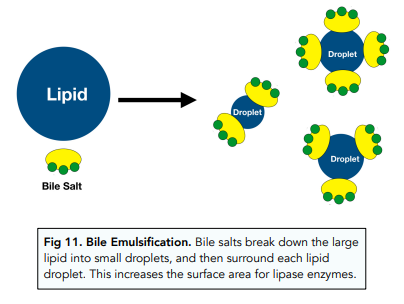
Tests
Test for Protein Using Biuret Test
- Prepare your protein sample.
- Make the solution alkaline by adding a few drops of potassium hydroxide.
- Then add copper (II) sulphate. This is bright blue.
- Analyse your results:
- If protein is present – sample will change colour from blue to purple
- If NO protein is present – it remains blue
Test for Lipids (Fats) Using an Emulsion Test
- Prepare your lipid sample.
- Add some ethanol. Shake well for a minute so the ethanol dissolves.
- Add some water.
- Analyse your results.
- If lipid is present – precipitate will form giving a milky emulsion appearance. The more lipid, the more milky it will be
- If lipid is NOT present – no milkiness will be seen
Test for Vitamin C Using the DCPIP Test
- Prepare your Vitamin C sample.
- Add DCPIP solution drop by drop. This solution is blue.
- Analyse your results:
- If Vitamin C is present – your solution will start to turn colourless with each drop. The more vitamin c present, the more drops of DCPIP it will take for the solution to completely turn colourless
- If Vitamin C is NOT present – the solution remains blue
Enzymes are biological molecules that help to speed up chemical reactions in the body. They are specifically designed to catalyze certain reactions, which means that they make it easier for the reaction to occur.
The role of enzymes in digestion is to help break down food into smaller, more easily absorbed molecules. Different enzymes are responsible for breaking down different types of food, such as proteins, carbohydrates, and lipids.
Enzymes break down proteins and lipids in the body by breaking the bonds between the individual building blocks of these macromolecules. This results in the formation of smaller, more easily absorbed molecules.
The role of enzymes in protein digestion is to break down large proteins into smaller peptides, which can then be further broken down into individual amino acids. These amino acids are then absorbed into the bloodstream and used by the body for various functions.
The role of enzymes in lipid digestion is to break down large lipids into smaller, more easily absorbed fatty acids and glycerol. These smaller molecules can then be absorbed into the bloodstream and used by the body for various functions.
The presence of enzymes greatly increases the rate of digestion, as they provide the energy needed to break down food into smaller, more easily absorbed molecules. Without enzymes, the digestion process would occur much more slowly or not at all.
Different types of food can affect the activity of digestive enzymes in different ways. For example, acidic foods can cause the production of more digestive enzymes, while high-fat foods can slow down the activity of digestive enzymes.
The importance of enzyme activity in the digestive process is that it provides the energy needed to break down food into smaller, more easily absorbed molecules. Without enzyme activity, the digestion process would occur much more slowly or not at all.
The pH of the digestive system can greatly affect the activity of digestive enzymes. Enzymes work best within a specific pH range, and a change in the pH of the digestive system can cause the activity of the enzymes to decrease or increase.
If there is an imbalance of digestive enzymes in the body, it can result in a number of digestive problems, such as indigestion, bloating, and diarrhea. An enzyme deficiency can also lead to malnutrition, as the body is unable to absorb the nutrients from food effectively.






Still got a question? Leave a comment
Leave a comment